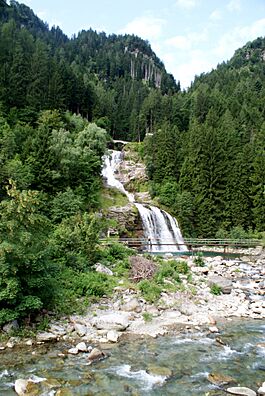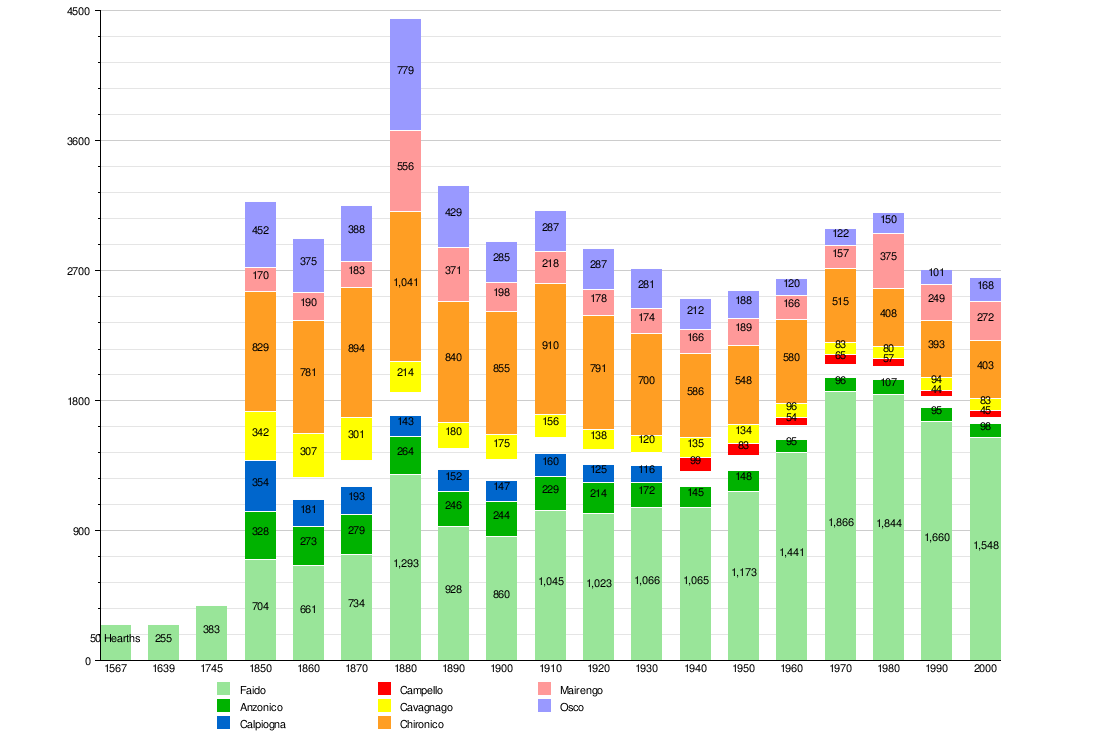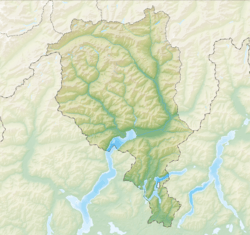Faido facts for kids
Quick facts for kids
Faido
|
||
|---|---|---|

Waterfall near Faido village
|
||
|
||
| Country | Switzerland | |
| Canton | Ticino | |
| District | Leventina | |
| Area | ||
| • Total | 132.6 km2 (51.2 sq mi) | |
| Elevation | 711 m (2,333 ft) | |
| Population
(Dec 2020 )
|
||
| • Total | 2,823 | |
| • Density | 21.290/km2 (55.140/sq mi) | |
| Postal code |
6760
|
|
| Localities | Chiggiogna, Rossura, Calonico | |
| Surrounded by | Acquarossa, Anzonico, Blenio, Calpiogna, Campello, Chironico, Dalpe, Mairengo | |
Faido is a town in southern Switzerland. It is the main town of the Leventina district. Faido is located in the Ticino canton, where people speak Italian.
Faido has grown over the years by joining with nearby villages. On January 29, 2006, the villages of Chiggiogna, Rossura, and Calonico became part of Faido.
Later, on April 1, 2012, Faido grew even more. It welcomed the former towns of Anzonico, Calpiogna, Campello, Cavagnago, Chironico, Mairengo, and Osco.
Finally, on April 10, 2016, Sobrio also joined Faido.
Contents
History of Faido
Faido was first mentioned in old papers in 1171. It was known as Faedo back then. Its location was very important for its growth. Faido sits in the middle of a valley, at the bottom of the Mount Piottino gorge.
This mountain gorge was a tough barrier for travelers and goods. So, people had to stop in Faido. This made Faido a key resting place.
When the Uri region ruled (from the 15th to 18th century), Faido was the capital of Leventina. It helped Uri control the Ticino area. Important meetings for the local leaders were held here.
Churches and Monasteries
In the Middle Ages, the church of San Siro in Mairengo was very important. It was first mentioned in 1171. The village church of S. Andrea in Faido was first noted in the 13th century.
After a fire in 1331, S. Andrea was rebuilt. In 1579, it became a main church for the area. It was made even bigger in 1830.
A Capuchin monastery was started in Faido in 1607. It became a center for learning and culture. The monastery school taught boys from the valley. The monastery has the Church of San Francesco, built in 1608. It was rebuilt in 1785-86.
Modern Times and Growth
The 19th century was a time of big changes for Faido. The Gotthard road was built from 1820 to 1830. Then, the Gotthard Rail Tunnel was built between 1871 and 1881.
The railway helped new hotels open, like the Hôtel Suisse in 1905. It also helped small businesses grow. In 1889, Faido was the first town in Ticino to have electric lights!
Many people from Leventina moved to other countries. But Faido also saw new people come in. They started small businesses. Before World War I, Faido was a popular holiday spot. Many families from Milan came to visit.
The Leventiner Hospital S. Croce was built in 1917. It became a retirement home in 1992. A new District Hospital was built in 1923. In 1976, Faido got a bypass tunnel to avoid a highway cutting through the town.
Geography of Faido
Faido covers an area of about 25.4 square kilometers (9.8 square miles). A small part of this land, about 3.4%, is used for farming. Forests cover about 9.3% of the area.
About 3.1% of Faido's land has buildings or roads. A tiny part, 0.3%, is rivers or lakes. The rest, about 0.2%, is land that cannot be used for farming or building.
Faido is the main town and home to the district court of Leventina.
Faido's Coat of Arms
The coat of arms for Faido is red. It shows a white cross that looks like it's been cut. From the cross, a white hand comes out, giving a blessing. The hand wears a purple sleeve.
People of Faido
Faido has a population of about 1,522 people. Many people in Faido speak Italian. About 84.2% of the population uses Italian as their main language.
The second most common language is Serbo-Croatian, spoken by about 7.7% of the people. German is the third most common, spoken by 3.5% of the population.
In 2009, about 7.1% of the people in Faido were children aged 0 to 9 years old. Teenagers, aged 10 to 19, made up about 10.2% of the population.
Historic Population
The historical population is given in the following chart:

Important Heritage Sites
Faido and its nearby villages have several important historical places. These are called heritage sites of national significance. They are protected because of their history and beauty.
Some of these sites include:
- The Church of S. Ambrogio
- The Torre Pedrini (a tower)
- The parish church of S. Siro
- The Selvini House
- The Church of S. Maria Assunta
- The parish church of SS. Lorenzo e Agata
The church of S. Siro is very old. It was first mentioned in 1170. It might even be from the 11th century. It is one of the oldest churches in the Leventina valley.
Economy and Jobs
In Faido, people work in different types of jobs.
- Some people work in farming. This is called the primary sector.
- Others work in factories or making things. This is the secondary sector.
- Many people work in services, like shops, hotels, or offices. This is the tertiary sector.
In 2005, there were 54 people working in farming. About 208 people worked in factories. The largest group, 651 people, worked in services.
Many people who live in Faido travel to other towns for work. Also, many people from other towns come to Faido to work. Faido has more people coming in for work than leaving.
In 2009, Faido had 4 hotels. They offered a total of 48 rooms and 94 beds for visitors.
Religion in Faido
Most people in Faido are Roman Catholic. In 2000, about 76.8% of the population belonged to the Roman Catholic Church. A smaller number, about 2.4%, were part of the Swiss Reformed Church.
Weather in Faido
Faido gets a good amount of rain or snow each year. On average, it has about 106 days with precipitation. The total amount of rain or snow is about 1416 millimeters (55.7 inches) per year.
The wettest month is May. During May, Faido gets about 151 millimeters (5.9 inches) of rain or snow. It rains or snows for about 11.8 days in May.
The driest month is December. In December, Faido gets about 67 millimeters (2.6 inches) of precipitation. It rains or snows for about 7.4 days in December.
Education in Faido
Many adults in Faido have completed higher education. This means they went to a special school after high school, like a university.
In 2009, there were 305 students in Faido.
- There were 33 children in kindergarten.
- For primary school, 79 students attended regular classes.
- In middle school, 70 students were in the two-year program.
- Some students (34) were in a four-year program to get ready for higher education.
After middle school, students can choose different paths.
- Some go to vocational schools. They learn a trade while working. In Faido, 21 students were full-time vocational students, and 58 were part-time.
- Other students go to a professional program. This program lasts three years. It prepares them for jobs in areas like engineering or nursing. There were 6 students in this program.
Transport
Faido has its own train station. The Lavorgo station is also within the town's borders. Both stations are on the Gotthard railway line.
Images for kids
-
Construction of the Gotthard Base Tunnel near Faido
See also
 In Spanish: Faido para niños
In Spanish: Faido para niños








